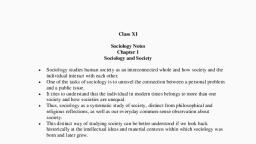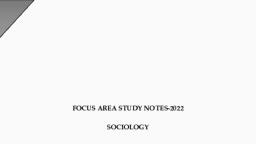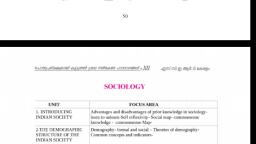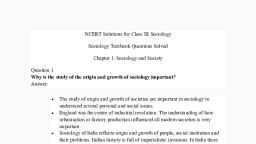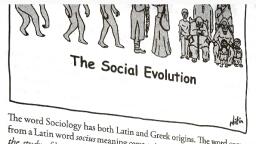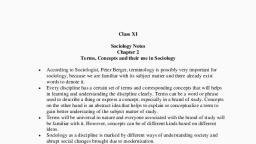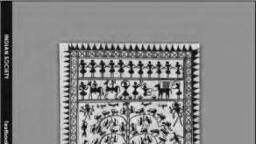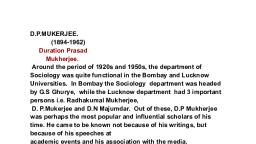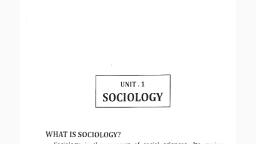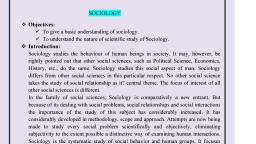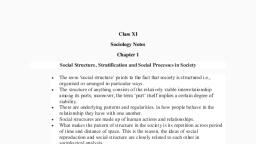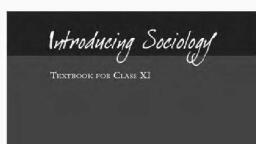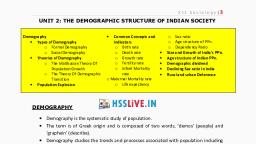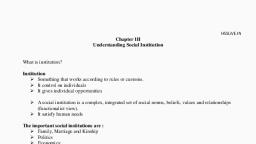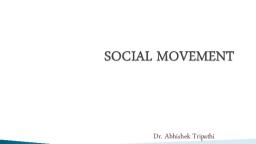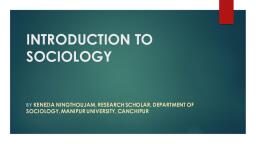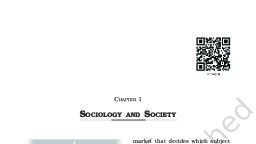Page 1 :
FOCUS AREA NOTES, PLUS ONE SOCIOLOGY, CHAPTER 1, , SOCIOLOGY AND SOCIETY, Sociological Imagination, Sociological Imagination, the theory was propounded by C., Wright Mills, an American sociologist. Mills used this term to, analyse the relationship between personal problems and, public issues. He points out that all personal problems are, emerged from certain public issues. Sociologists have the, capacity to imagine the public issue in which a personal, problem arises. This is what he called Sociological, Imagination., Sociology and Common sense Knowledge, The common sense explanations are generally based on, what may be called naturalistic and/or individualistic, explanations. A Scientific base is not essential for this., Sociology has a body of concepts, methods and data. This, can't been seen in common sense knowledge. Common, sense is unreflective, since it does not question its own, origin. But the sociologist must be ready to ask any of our, beliefs, about ourselves no matter how cherished Is this, really so? To accept the most reliable and proved facts, definitely we can say that sociology has a scientific, approach.
Page 2 :
Relationship between Sociology and other, social sciences, Sociology and Psychology, Psychology is defined as the science of behaviour. It is, interested the study of intelligence and learning,, motivations and memory, nervous system etc. Social, psychology, which serves as a bridge between psychology, and sociology. It studies how individual behaves in social, groups. Sociology attempts to understand the way in which, personality is shaped by different aspects of society., Sociology, Study of social behaviour, Study of social processes, Social approach, Society is the lab of, sociology, Individual’s are considered, as a part of society, , Psychology, Study of individual behaviour, Study of mental processes, Individual approach, Wide use of lab experiments, Society is mere collection of, individuals, , Sociology and Social Anthropology, Sociology and Anthropology are closely related. These two, branches of knowledge study the same subject matter, i.e, man. A. L. Kroeber calls sociology and Anthropology, the, twin sisters., The following are the main differences between Sociology, and Social Anthropology, Sociology, Anthropology, Study of modern society, Study of primitive society, Using ethnographic methods Survey method, Study of racial aspects, Stresses on social aspects
Page 3 :
CHAPTER 2, TERMS, CONCEPTS AND THEIR USE IN, SOCIOLOGY, Aggregate/Quasi Group, Aggregates are simply collections of people who happen to, be in the same place at the same time. They do not have, definite connection with one another. For example,, Passengers waiting at a Railway Station, Airport or bus, stop, etc., A quasi group is an aggregate which lacks structure or, organisation and whose members may be unaware of the, existence of groupings. Social classes, status groups, age, and gender groups, crowds are the examples of quasi, group., Social Group, Social group refers to a collection of continuously interacting, persons who share common interest, culture, values and, norms within a given society., Characteristics of Social Group, (i) Persistent interaction to provide continuity, (ii) A stable pattern of these interactions, (iii) A sense of belonging to identify with other, members, (iv) Shared interest, (v) Acceptance of common norms and values, (vi) A definable structure, Types of Social Groups, The following are the main types of Social Groups:, Primary and Secondary Social Groups, Primary group refers to a small group of people connected
Page 4 :
by intimate and face-to-face association and co-operation., Family, village and groups of friends are the examples of, primary groups., Secondary groups are relatively large in size, maintain, formal and impersonal relationships. Secondary groups are, goal oriented rather than person oriented. Schools,, government offices, hospitals, student’s associations etc., are the examples of secondary groups., Community and Society or Association, The term community refers to human relationships that are, highly personal, intimate and enduring., Society or association refers to everything opposite of, community. Society is marked by impersonal, superficial, and transitory relationships of modern urban life., In-Groups and Out-Groups, A sense of belonging marks an in group. The feeling of ‘us’, or ‘we’ separates in group from other groups. The children, belonging to a particular school form an in-group., Out-Group is a group which the members of an in-group do, not belong. The members of an out group can face hostile, reactions from the members of in-group. Migrants are an, example of out-group., Reference Group, The groups whose life styles are imitated are known as, reference groups. Reference groups are important source of, information about culture, life style, aspiration and goal, attainments., Peer Groups, peer groups are usually formed between individuals of of, similar age or interests or in a common professional group,, they can be described as group of equals. Class mates at, school are an example of peer group.
Page 5 :
SOCIAL STRATIFICATION, Social stratification refers to the existence of structured, inequalities between groups in society. Historically four, systems of stratification have existed in human societies:, 1. Slavery, 2. Estate, 3. Caste, 4. Class, Caste, In caste system, the position of an individual is determined, by birth. In traditional India, different castes formed a system, of hierarchy. the caste structure was based on the concept, of purity and pollution. In the caste structure Brahmin or, priestly castes are superior to all other castes. Panchamas, who were often described as out castes, were inferior to all, other castes. The social structure in traditional India was, based on the four fold Varna system. It consisted of, Brahmins, Kshatriyas, Vaishyas and Shudras., The caste system in India has undergone considerable, changes over the years. Changes brought in by urbanisation, inevitably challenged this. It completely altered caste, system., Class, A social class is an aggregate of people having more or less, equal status in a given society. Scholars have made several, attempts to explain class., Marx defined classes on the basis of their relation with the, means of production. According to him the industrial society, consisted of two classes: the capitalist class and working, class., Weber defined class on the basis of life chances. He argued, that the inequality was based on economic relations,
Page 6 :
prestige and political power., The functionalist theory believes that no society is classless., They accept the reality that society is stratified., Difference between Caste and Class, Caste, , Class, , Based on birth, Rigid, Inherited through generations, Indian phenomenon, , Based on economic position, Flexible, Achievement based, Universal or global, , Status and Role, Status and role are twin concepts. Status is simply a, position an individual has in society or in a group. Status, refers to social positions. Role is the dynamic or behavioural, aspect of status. Status is occupied while role is played., There are two types of status:, (1) Ascribed status, (2) Achieved status, Ascribed status is a position which a person occupies by, birth. For example, the positions occupied through age,, caste, race etc., Achieved status is a social position that a person occupies, voluntarily by personal ability, achievements and choices., The most common bases of achieved status are educational, qualification, income and professional expertise., Role conflict is the disagreement among roles, corresponding to one or more status. Role conflict occurs, from contrary expectations arising from two or more roles., Role stereotyping is a process of fixing some specific role, for some members of the society. For example, society, decides some roles for men and women. Accordingly, men, are the bread winners and women are the home maker.
Page 7 :
Society and Social Control, Social control is a system of devices where by society, brings its members into conformity with accepted standards, of behaviour. Each society has its own methods to regulate, its members. Social control is essential for the existence of, the society., There are different views among sociologists regarding, social control., According to the functionalist view society is a harmonious, one. For functionalist perspective social control refers to :, 1. The use of force to regulate the behaviour of individual, and groups., 2. The enforcing of values and patterns for maintaining, order society., Conflict theorists argues that social control is mechanism to, impose the control of dominant social classes on the rest of, society., Types of Social Control, There are two types of social control:, (i) Formal Social Control, (ii) Informal Social Control, When the codified and systematic mechanism of control is, used, it called formal social control. For example, police ,, law and state., Informal social control is personal, unofficial and uncodified., They include smiles, making faces, body language, criticism, etc.
Page 8 :
CHAPTER 3, , UNDERSTANDING SOCIAL INSTITUTIONS, Institutions are something that work according to rules, established or by law or by custom. Institutions impose, constraints on individuals. They also provide him/her with, opportunities., A functionalist view understands social institutions as a, complex set of social norms, beliefs, values and role, relationship that arise in response to the needs of society., A conflict view holds that all individuals are not placed, equally in society. All social institutions whether familial,, religious, political, economic, legal or educational will, operate in the interest of the dominant sections of society, FAMILY, A family is a group of persons directly linked by kin, connections. the adult members of which assume, responsibility for caring for children. Family Is the most, ‘natural’ universal and unchanging institution., Forms / Types of Family, With regard to the rule of residence, a). Matrilocal: The newly married couple stays with the, woman’s parents., b). Patrilocal: The couple lives with the man’s parents., With regard to the rules of inheritance, a). Matrilineal societies pass on property from mother to, daughter., b). Patrilineal societies do so from father to son., With regard to the power/authority, A patriarchal family structure exists where the men exercise, authority and dominance,matriarchy where the women play, a similarly dominant role.
Page 9 :
MARRIAGE, Marriage can be defined as a socially acknowledged and, approved sexual union between two adult individuals., Forms of marriage, 1) Monogamy :Under this system, at any given time a man, can have only one wife and a woman can have only one, husband. Monogamy is more widely prevalent., Serial monogamy:In many societies, individuals are, permitted to marry again, after the death of the first spouse, or after divorce. But they cannot have more than one, spouse at one and the same time. Such a monogamous, marriage is termed serial monogamy., 2) Polygamy denotes marriage to more than one mate at, one time and takes the form of either: Polygyny-one, husband with two or more wives or Polyandry -one wife, with two or more husbands., Rules of Marriage -Endogamy and Exogamy, Based on rules governing eligibility/ ineligibility of mates is, classified as endogamy and exogamy., Endogamy requires an individual to marry within a culturally, defined group, Exogamy, the reverse of endogamy, requires the individual, to marry outside of his/her own group., Kinship, Kinship ties are connections between individuals,, established either through marriage or through the lines of, descent that connect blood relatives., Types of Kinship, The kin who are related through “blood” are called, consanguinal kin while the kin who are related through
Page 10 :
marriage are called affines., Religion, Religion exists in all known societies, although religious, beliefs and practices vary from culture to culture., Characteristics ́, - Set of symbols, invoking feelings of, - Reverence or awe, - Rituals or ceremonies, - A community of believers., Emile Durkheim, argue that religion distinguishes sacred, realm from the profane., Max Weber argue that religion, does have an influence on, economic development., EDUCATION, Education is a life long process, involving both formal and, informal institutions of learning., For the functionalists, education maintains and renews the, social structure, transmits and develops culture., Conflict theorist argue that schooling ‘intensifies the, existing divide between the elite and the masses.
Page 11 :
CHAPTER 4, CULTURE AND SOCIALIZATION, Definition of culture, According to Edward Tylor. "Culture is that Complex whole, which includes knowledge, belief, art, morals, laws, custom, and any other capabilities and habits acquired by man as a, member of society" Culture is the man-made part of, environment., Dimensions of culture, Culture has three dimensions or aspects; cognitive,, normative and material., 1. Cognitive; cognitive means knowing or perceiving an act., This refers to how we learn to process what we hear and, see and to give it meaning. For example, identifying the, ring tone of a cell phone as ours, or identifying the, cartoon of a politician., 2. Normative; this refers to the rules of contact. Eg: not, opening others letters, performing rituals at death etc., 3. Material; this includes any activity with the help of, materials. Materials include tools or machines. Eg:, internet chatting and designing Kolam using rice- flour., Cultural Lag, Material aspects of culture change rapidly, while non, material aspects change very slowly. There exists a wide, gap between these two aspects. This condition is called, cultural lag., Culture and Identity, identities are not inherited. Individuals and groups form their, identity through their relationship with others. The identity of, an individual gets imparted through the social roles he/she, plays.
Page 12 :
A culture has many sub cultures. Sub cultures have their, own style, taste and association. They can be identified, through their speech, dress codes, music or manner of, interaction etc., Ethnocentrism, Ethnocentrism is the application of one’s own cultural values, in evaluating the behaviour and beliefs of people from other, cultures. The basis of this concept is the thought that our, culture is superior to that of others., Cosmopolitanism, Cosmopolitanism is the opposite of ethnocentrism. It values, other cultures for their difference. An individual with, cosmopolitan outlooks does not evaluate the values and, beliefs of other people on the basis of his/her own culture., Cosmopolitanism respects and accommodates different, cultures., Cultural Change, Cultural change is the way in which societies change their, patterns of culture. It can occur through changes in the, natural environment or contact with other cultures. Cultural, change may be revolutionary also. When a culture, transforms rapidly, its values and meaning systems undergo, radical changes and thus revolutionary changes take place., Eg: French Revolution., SOCIALISATION, Socialisation is the most important process in the life of an, individual. This process extending from birth to death of, human beings. Socialisation can be defined as a process by, which the helpless infant gradually becomes a self-aware,, knowledgable and skilled person in the ways of culture into, which he/she is born.
Page 13 :
Agencies of Socialisation, A child is socialised by several agencies like family, peer, group, school, mass media, neighbourhood, occupational, group, social class, caste, region, religion etc., The following are the main agencies of socialisation;, 1. Family, 2. Peer group, 3. School, 4. Mass media, 5. Other agencies, Family, family is the first agent of socialisation. The process of, socialisation begins from family. In most traditional societies,, the individual’s social position is determined by the family., Peer groups, peer groups are friendship groups of children of a similar, age. The word peer means equal. Friendly relations, established between young children may be egalitarian., Schools, Schools are important agencies of socialisation. Knowledge, and values imparted by teachers help children in the, process of socialisation. Sociologists have pointed out that, there is a hidden curriculum in schools along with the formal, curriculum., Mass Media, Today, mass media has become an integral part of our daily, life. Television, Radio, Print media, Social media, etc. are, important mass media. The media can make the access to, information more democratic., Other socialising agencies, Besides the above mentioned socialising agencies, religion,, law, rituals, region, occupational group, social class, caste, etc. are other agencies of socialisation.
Page 14 :
CHAPTER 5, DOING SOCIOLOGY, The word ‘methodology’ actually refers to the study of, method., The word ‘objective’ means unbiased, neutral, or based on, facts alone. The word ‘subjective’ means something that is, based on individual values and preferences., All science is expected to be ‘objective’, to produce, unbiased knowledge based on facts. But this is much, harder to do in the social sciences than in the natural, sciences., Problems with objectivity in sociology are:, 1) Social scientists study the world in which they themselves, live., 2) There are many versions of the ‘truth’ in the social world., 3) The presence of multiple points of view in the social, sciences themselves, The quantitative methods deal in countable or measurable, variables, proportions, averages, etc, Qualitative methods deal with more abstract and hard to, measure phenomena like attitudes, emotions and so on, Secondary method rely on ‘secondary’ or already existing, data in the form of documents or other records and, artefacts., Primary methods produce fresh or ‘primary’ data., The micro methods are designed to work in small intimate, settings usually with a single researcher; thus the interview, and participant observation are thought of as micro, methods., Macro methods are those that are able to tackle large, scale research involving large numbers of respondents and
Page 15 :
investigators. Survey research is the most common example, of a ‘macro’ method, Triangulation, The recent trend in social science is to advocate the use of, multiple methods to bear on the same research problem, from different vantage points., Participant Observation, Popular in sociology and specially social anthropology,, participant observation refers to a particular method by, which the sociologist learns about the society, culture and, people, Field work involves a long period of interaction with the, subjects of research., Field work learn about the ‘whole way of life’ of a, community., Bronislaw Malinowski, a Polish anthropologist established, field work as the distinctive method of social anthropology., Steps of field work in Social Anthropology, 1) Making a detailed list of all the people who lived in a, community, including information such as their sex, age, group and family., 2) Map the physical layout of the village or settlement, 3) Construct a genealogy (family tree) of the community, 4) Making detailed notes on the significant aspects of, community life like festivals, religious events, etc., 5) Anthropologist keeps detailed field notes during field work, FIELD WORK IN SOCIOLOGY, Sociological field work did not necessarily involve living in., The researcher already knows the society., He is dealing with a literate people
Page 16 :
Important field work studies, James Frazer, William Foote Whyte, Michael Burawoy, William Wiser, S.C. Dube, M.N. Srinivas, , The Golden Bough, Street Corner Society, Perspective of workers, Behind Mud Walls, Indian Village, The Remembered Village, , Survey, The survey is probably the best known sociological method, and it is an attempt to provide an overview., The survey questions may be asked and answered in, various forms., i) Personal visits by the investigator, ii) Through telephone conversations., Iii) Sent through the post., iv) Conducted electronically-email, the Internet, or similar, electronic medium., Advantage of Survey, It allows us to generalise results for a large population by, studying a small portion of this population., Survey makes it possible to study large populations with a, manageable investment of time, effort and money., Interview, An interview is basically a guided conversation between the, researcher and the respondent. The interview is dependent, on personalised access and the degree of rapport or mutual, trust between the respondent and the researcher., There are two types of interview:, (i) Structured interview, (ii) No structured interview
Page 17 :
CHAPTER 6, SOCIAL STRUCTURE, STRATIFICATION AND, SOCIAL PROCESSES IN SOCIETIES SOCIAL, STRUCTURE, Social structures are made up of human actions and, relationships. it repeats across periods of time and space., So the ideas of social structure is very closely related to, social reproduction. Giddens compares social structure with, that of a building., Social stratification, Social stratification refers to the existence of structured, inequalities between groups in society, in terms of their, access to material or symbolic rewards., Stratification in modern societies involve class divisions,, race and caste, region and community, tribe and gender, The society is divided into a patterned structure of unequal, groups, and this structure tends to persist across, generations., Advantage of privileged groups, There are three basic forms of advantages which privileged, groups may enjoy:, (i) Life Chances: All those material advantages which, improve the quality of life of the recipient — this may include, not only economic advantages of wealth and income, but, also benefits such as health, job security and recreation., (ii) Social Status: Prestige or high standing in the eyes of, other members of the society., (iii) Political Influence: The ability of one group to, dominate others.
Page 18 :
SOCIAL PROCESSES, i) Cooperation, Working together for common/mutual benefit., Both Karl Marx (conflict perspective) and Emile, Durkheim(functionalist perspective) agree that human, beings have to cooperate to meet their basic needs. There, are two types of cooperation., - Voluntary cooperation, - Enforced cooperation, When conflicts are not expressed openly the impression, remains that there is no conflict, but only cooperation., A functionalist view often uses the term accommodation to, explain this situations, While Durkheim emphasised altruism and solidarity as, distinctive of the human world, Marx emphasised, consciousness., ii) Competition, Competition is a social entity that emerges and becomes, dominant in society at a particular historical point of time., Classical sociological thinkers such as Emile Durkheim and, Karl Marx have noted the growth of individualism and, competition respectively in modern capitalist societies. J.S, Mill described modern competition as the fight of all against, all., iii) Conflict, - The term conflict implies clash of interests, - Conflict present in all societies, - Conflict appears as an overt clash only when it is openly, expressed., For example, the existence of a peasant movement is an, overt expression of a deep rooted conflict over land, resources., But the absence of a movement does not means the, absence of a conflict.
Page 19 :
CHAPTER 7, , SOCIAL CHANGE AND SOCIAL ORDER IN RURAL, AND URBAN SOCIETY, Change is the law of nature. All societies undergo changes., Change is the only thing that does not change in society., Constant change is the most permanent features of our, society. Social change has to be understood together with, social order., SOCIAL CHANGE, Social change refers to significant changes. These are the, changes which alter the structure of society., Social changes include only big changes which transform, things fundamentally. Changes have to be both intensive, and extensive. They should make big impact over a large, sector of society., Types/kinds of Social Change, 1. Evolutionary Changes, 2. Revolutionary Changes, 3. Structural Changes, 4. Change in Values and Beliefs, Evolutionary Changes, The change that takes place slowly over a long period is, called evolutionary change. Charles Darwin proposed the, Theory of Evolution. According to him, all living organism, evolve and change slowly over several centuries by, adapting themselves to natural circumstances. Darwin’s, theory stressed the idea of ‘the survival of the fittest’., Darwin’s theory of evolution describes the natural, processes. But it was soon used to evaluate the changes of, social world. It was called social Darwinism., Revolutionary Changes, Revolutionary change is an opposition of evolutionary
Page 20 :
changes. The change that quickly and even suddenly is, called ‘revolutionary changes’. Revolutionary change occurs, mainly in political context. When ruling class is overthrown, by it opponents, the power structure of the society changes, creating revolutionary changes. The French Revolution, The, Russian Revolution, The Industrial revolution,, Telecommunication revolution, etc. are the examples of, revolutionary changes., Structural Changes, Structural change refers to transformation in the structure of, society. It includes the change in the social institutions and, the rules by which these institutions are run. For example,, the emergence of paper money was a structural change in, financial markets and transactions, paperless money or, electronic economy, etc., Change in Values and Beliefs, Changes in values and beliefs can also lead to social, changes. For example, changes in the ideas and beliefs, about children and childhood have brought about important, social change. There was a time when the concept of, childhood did not exist. Children were considered as small, adults. They did not have any consideration of children. For, example, the attitude towards child labour., Causes or Sources of Social Change, There are five broad types of sources or causes of social, change:, 1. Environment, 2. Technology, 3. Economy, 4. Politics, 5. Culture, Environment, Environment plays a significant role in shaping societies and, bringing social changes. Natural disasters (flood,
Page 21 :
earthquake, Tsunami, etc.,)can be taken as an example. It, often lead to a total transformation or destruction of, societies., Technology and Economy, The combination of technological and economic change, leads to social change. Technology helps us to resist,, control and adapt to nature in different ways. Technology, has created impressive changes in society in combination, with the market. The most important social change brought, about technological change is, the industrial revolution. Sometimes non-technological, changes in economic organisation can also change society., Plantation agriculture is a well-known historical example., Politics, Political forces have been the most important cause of, social change. Change in the existing power system leads, to change of the society. For example, The Indian, independent movement brought about political change by, ending British rule., Culture, Culture refers to the ideas, values and beliefs that shape the, life of the people. Changes in ideas and Beliefs naturally, lead to change in social life. For example, change in, religious beliefs. Max Weber’ s study ‘the Protestant Ethic, and Spirit of Capitalism’ showed how the religious beliefs of, some protestant sects helped to establish the capitalist, social system., SOCIAL ORDER, Social order is the tendency within established systems that, resists and regulates changes. Every society should, maintain its stability in order to stand as a strong and, efficient social system. Those who are in a higher position, wish to continue the social order and those who are, suffering disadvantages are anxious for change.
Page 22 :
Social order can be achieved in one of two ways:, 1. When people willingly obey rules and norms., 2. When people are compelled to obey such rules and, norms., Every society employs a combination of these methods to, maintain social order., Domination, Authority and Law, Domination is the situation in which power became stable, and settled, and the parties involved become accustomed to, it. Dominant group obtain the cooperation of the people, through power. Domination cannot be maintained merely, through the use of force. It requires legitimation., Legitimation refers to the degree of acceptance. Max, Weber defines authority as legitimate power., Law plays an important role in maintaining domination and, authority. Law is an explicitly codified norm or rule. Law is, usually written down. Law is applicable to all citizens., Social Order and Social Change in Rural Areas, The social structure of villages follows a traditional pattern., The traditional social institutions like caste and religion are, stronger in villages. Therefore, change is slower in villages, than in towns. The dominant sections are very powerful in, rural areas. They control all kinds of employment and, resources. The changes in agriculture and agrarian social, relations have made deep impact on village societies., Expansion of education, introduction of communication and, transportation facilities, Land Reform Act, Green revolution,, etc. are the main factors of social change in rural areas., Social Order and Social Change in Urban Areas, Sociologists have pointed out that urban life and modernity, go together. City contains large and dense population.
Page 23 :
Anonymity and individuality are main features of modern, cities. Lack of sanitation and slums are the main problem, are the main problems of cities. Slums are congested and, over crowded dwelling places of poor people. Slums are, also the breeding grounds of ‘gundas’ and ‘dadas.’ they, impose their authority on the people live there. Residential, areas in cities all over the world are segregated by class,, race, ethnicity and religion., Ghettoisation, In India, communal tensions between religious communities, results in the conversion of mixed neighbourhoods into, single community ones. This is called ‘Ghettoisation.’, Gated communities, The world wide phenomenon of ‘Gated communities’ is also, found in Indian cities. Gated communities refers to the, creation of affluent neighbourhoods that are separated from, their surroundings by walls and gates with controlled entry, and exit., Another important problem of the cities related with, transport and travelling facilities. Reliance on road transport, and private vehicles creates problems of traffic congestion, and vehicular pollution. Social changes in many forms and, content occur in urban areas., Gentrification, A related phenomenon is ‘Gentrification’. It refers to the, conversion of a previously lower class neighbourhood into a, middle and upper class one.
Page 24 :
CHAPTER 8, ENVIRONMENT AND SOCIETY, Every society has an ecological base. The web of physical, and biological systems and processes is called ecology., Humans are the part of this systems. Mountains, rivers,, plains, oceans, plants and flora and fauna are a part of the, ecology., Social Environments, Social environment emerge from the interaction between, bio-physical ecology and human interventions. This is two, way process. Nature shapes society and society shapes, nature., Social Organisation, The interaction between the environment and society is, shaped by nature. Property relations determine how and by, whom natural resources can be used. For example, the, government has the power to decide what to do with the, forest owned by it., Risk Societies, We live in risk societies. Complex industrial technologies, and mode of organisation require sophisticated, management systems which are often fragile and vulnerable, to error. The occurrence of nuclear disasters like Chernobyl,, industrial accidents like Bhopal, and Mad Cow disease in, Europe shows the dangers in industrial environment., Social Values and Norms, The social values and norms reflected in the different, relationship between environment and society. The capitalist, values support the commodification of nature. The socialist, values stands for justice and equality. The religious values
Page 25 :
inspired certain communities to protected the sacred, forests(groves) and species., Major Environmental Problems and Risks, The following are the major environmental problems and, risks., 1. Resource Depletion, 2. Pollution, 3. Global Warming, 4. Genetically Modified Organisms, 5. Natural and man-made Environmental Disasters, Resource Depletion, The excessive use of non-renewable natural resources is, one of the most serious environmental problems. For, example, The depletion of water, top soil, biodiversity, habitats, etc., Pollution, There are three types of pollution- Air pollution, Water, pollution, Noise pollution., Air pollution: Air pollution is a major environmental problems, in urban and rural areas. The sources of air pollution include, emission from industries and vehicles., Water pollution: Water pollution is a serious environmental, problem. It affects the surface as well as ground water., Noise pollution: Noise pollution creates a lot of problems in, cities. It creates different types of health problems., Global Warming, Global warming is caused by greenhouse gases. The, emitted green house gases such as carbon dioxide,, methane, etc. Global warming affects the ecological, balance. It Creates uncertainties and fluctuation in climates, across the world.
Page 26 :
Genetically Modified Organisms, The technique of producing new characteristics in species, by importing the genes of one species into another is called, genetic modification. Multi-national companies use this, techniques to create sterile seeds. It will prevent the farmers, from reusing them., Natural and Man-made Environmental Disasters, Both natural and man-made disasters create a lot of, problems in our environment. Tsunami and Bhopal Disaster, are the examples of natural and man-made environmental, disasters respectively., Environmental Problems also Social Problems, Many a time environmental problems change into social, problems. Some environmental problems are universal., Such environmental problems will create public interest. But, the sociological analysis shows the attempts to protect the, public interest are not useful to all. The activities in the, name of protecting the public interest actually serve the, interests of the politically and economically powerful groups., They hurt the interest of the poor and politically weak., Social Ecology, Murray Bookchin, a political philosopher, is the founder of, the institute for Social Ecology. Social ecology points out, that the social relations have an important role in shaping, environmental perceptions. Different social groups have, different approaches and relations with the environment.
Page 27 :
CHAPTER 9, INTRODUCING WESTERN SOCIOLOGISTS, Sociology is sometimes called the child of the ‘age of, revolution’. This is because three revolutions paved the way, for the emergence of sociology., 1) The Enlightenment, or the scientific revolution, 2) The French Revolution, 3) The Industrial Revolution., The Enlightenment (scientific revolution), During the late 17th and 18tth centuries, Western Europe, saw the emergence of new ways of thinking about the world., The new philosophies established the human being at the, centre of the universe. Rational thought as the central, feature of the human being. Enlightenment helped to, develop, secular, scientific and humanistic attitudes., The French Revolution-1789, The French Revolution (1789) announced the arrival of, political sovereignty at the level of individuals as well as, nation-states. Declaration of Human Rights asserted the, equality of all citizens and questioned the legitimacy of, privileges inherited by birth. The ideals of the French, Revolution-liberty, equality and fraternity -became the, watchwords of the modern state., The Industrial Revolution, Industrial Revolution had two major aspects., 1.The first was the systematic application of science and, technology to industrial production., 2.Industrial revolution also evolved new ways of organising, labour and markets
Page 28 :
Factory based production and urban domination over the, rural. Cities and towns became the dominant forms of, human settlement. Slums are formed at the outskirts of the, towns. Thus Sociology-‘science of the new industrial society’, was formed., KARL MARX (1818-1883), Karl Heinrich Marx was a German philosopher, economist,, historian, sociologist, political theorist, journalist and, socialist revolutionary., Main works, 1. The Manifesto of the Communist Party (1948), 2. A Contribution to the Critique of Political Economy (1859), 3. Das Capital, Vol. I(1867), Class, Karl Marx argued that people who occupy the same position, in the social production process will eventually form a class., By virtue of their location in the production process and in, property relations, they share the same interests and, objectives, even though they may not recognise this, immediately., Class struggle, Marx believed that class struggle was the major driving, force of change in society. In The Communist Manifesto, Marx and Engels presented their views , Its opening lines, declare, ‘The history of all hitherto existing societies is, the history of class struggle’. As society evolved from the, primitive to the modern through distinct phases, each, characterised by particular kinds of conflict between the, oppressor and oppressed classes.
Page 29 :
In capitalism the bourgeoisie (or capitalists) owned all the, means of production, workers had no choice but to sell their, labour for wages in order to survive, because they had, nothing else., EMILE DURKHEIM (1858-1917), Emile Durkheim may be considered as the founder of, sociology as a formal discipline as he was the first to, become a Professor of Sociology in Paris in 1913. Durkheim, cherished the idea of developing a secular understanding of, religion. in his last book, The Elementary Forms of Religious, Life. His first book was The division of labour in society. He, use of a new kind of empirical data is in his study of Suicide., Division of Labour in Society, In his first book, Division of Labour in Society, Durkheim, demonstrated his method of analysis to explain the, evolution of society from the primitive to the modern. He, classified a society by the nature of social solidarity which, existed in that society. He argued that while a primitive, society was organised according to ‘mechanical’ solidarity,, modern society was based on ‘organic’ solidarity., Mechanical solidarity and Organic solidarity, The following are the main differences between mechanical, solidarity and organic solidarity., Mechanical Solidarity, , Organic Solidarity, , Similarity or Homogeneity, Small Population, Self sufficient groups, Repressive Laws, , Differences or Heterogeneity, Large Population, Interdependence, Restitutive Laws
Page 30 :
MAX WEBER (1864-1920), According to Max weber, there are three types of, authorities., Traditional Authority: source of traditional authority was, custom and precedence, Charismatic Authority: charismatic authority derived from, divine sources or the ‘gift of grace’,, Rational-legal Authority: rational-legal authority was based, on legal demarcation of authority., Rational- legal authority which prevailed in modern times, was epitomised in the bureaucracy., , Bureaucracy, Bureaucracy is a mode of organisation which premised on, the separation of the public from the domestic world. This, meant that behaviour in the public domain was regulated by, rules and regulations, Bureaucratic authority is characterised by these features:, (i) Functioning of Officials;, (ii) Hierarchical Ordering of Positions;, (iii) Reliance on Written Document, (iv) Office Management; and, (v) Conduct in Office.
Page 31 :
Functioning of Officials: Officials have fixed areas of, official jurisdiction based on certain rules and regulations., The regular activities of the bureaucratic organisation are, distributed as official duties., Hierarchical Ordering of Positions: There would be a, hierarchy of offices in Bureaucracy. This hierarchy is formed, on the basis of authority and positions. In this system, the, higher officials supervise the lower one., Reliance on Written Document: The management of, bureaucratic organisation is carried out on the basis of, written documents. These files are preserved as records., Office Management: Office management is specialised and, modern activity. It requires trained and skilled personnels to, conduct operations., Conduct in Office: An official’s conduct in office is, controlled by rules and regulations. He/She is responsible, for misbehaviour.
Page 32 :
CHAPTER 10, INDIAN SOCIOLOGISTS, G.S GHURYE (1893-1983), Major work: Class and Caste in India, The founder of Institutionalised Sociology in India., Founded the Indian Sociological Society as well as its, journal, "Sociological Bulletin"., ✍️He wrote on a broad range of other themes including, tribes, kinship, family, marriage, civilization., Ghurye on Caste, In his book Caste and race India, Ghurye provides a, detailed criticism of the dominant theories about the, relationship between the race and caste. He gave a, comprehensive definition of caste. His definition emphasises, six features., Features of Caste, 1)Segmental division, 2)Hierarchical division, 3)Caste involved restriction on social interaction, 4)Differential rights and duties for different castes, 5)Choice of occupation, 6)Marriage restrictions, D.P MUKERJI (1894-1961), According to D.P Mukerji Indian social system is basically, oriented towards group, sect or caste., Tradition and Change, The word tradition means "to transmit". According to Mukerji, the tradition of India was active and dynamic. The first duty, of Indian sociologists is the study of Indian tradition., Indian traditions recognised three principles of change:, 1) Shruti, 2) Smriti
Page 33 :
3) Anubhava, Anubhava is personal experience which is revolutionary, principle. In India the personal experiences flowered into, collective experiences., Smriti and Shruti were the centre of Indian tradition. This, were challenged from time to time by collective experience, of groups. This was true in the case of Hindu and Muslim, culture. Conflict worked through collective experiences., Conflict produced change in the tradition., A.R DESAI (1915-1994), A life long Marxist., Important work are Social Background of Indian Nationalism, and The Myth of welfare state, A.R Desai on the state, According to A.R Desai the unique features of welfare, state are:, 1) The welfare state is a positive state which uses, considerable power to design and implement social, policies to better societies., 2) Welfare state is a democratic state where democracy is, an essential element. Socialists and Communist states, are excluded from welfare state., 3) Welfare state is based on mixed economy where both, private capitalist business and public enterprises co, exist., M.N.SRINIVAS (1916-1999), The best known Indian Sociologist., Important work, Religion and Society among the Coorgs of, South India, M.N.Srinivas was interested in Indian village society through, the field work that he did in a village near Mysore. In 1950s, and 60s Srinivas produced detailed ethnographic account of
Page 34 :
village society., Srinivas’s village studies fall into two categories:, 1) Ethnographical account of field work in village., 2) Historical and conceptual discussion on Indian villages., Srinivas believed that village was a relevant social entities., Village had a unifying identity and village unity was, significant in rural social life., The British Anthropologists had pointed the Indian village as, unchanging, self sufficient, little republics., Srinivas objected to and rejected this view. Srinivas proved, that the village undergone considerable change. They were, never self sufficient and they had different relation at, regional level., , Contributors:, 1. Abdul Samad K.C, GHSS Vatakara, 9497646303, 2. Sajithkumar T.P, GHSS Kallachi, 9846724499, 3. Vincent P.J, GHSS Valayam, 9447352282, 4. Anilkishor, SGMGHSS Kolathur, 9744744274, 5. Bijeesh B, AJJMHSS Chathangottunada, 9995952626

